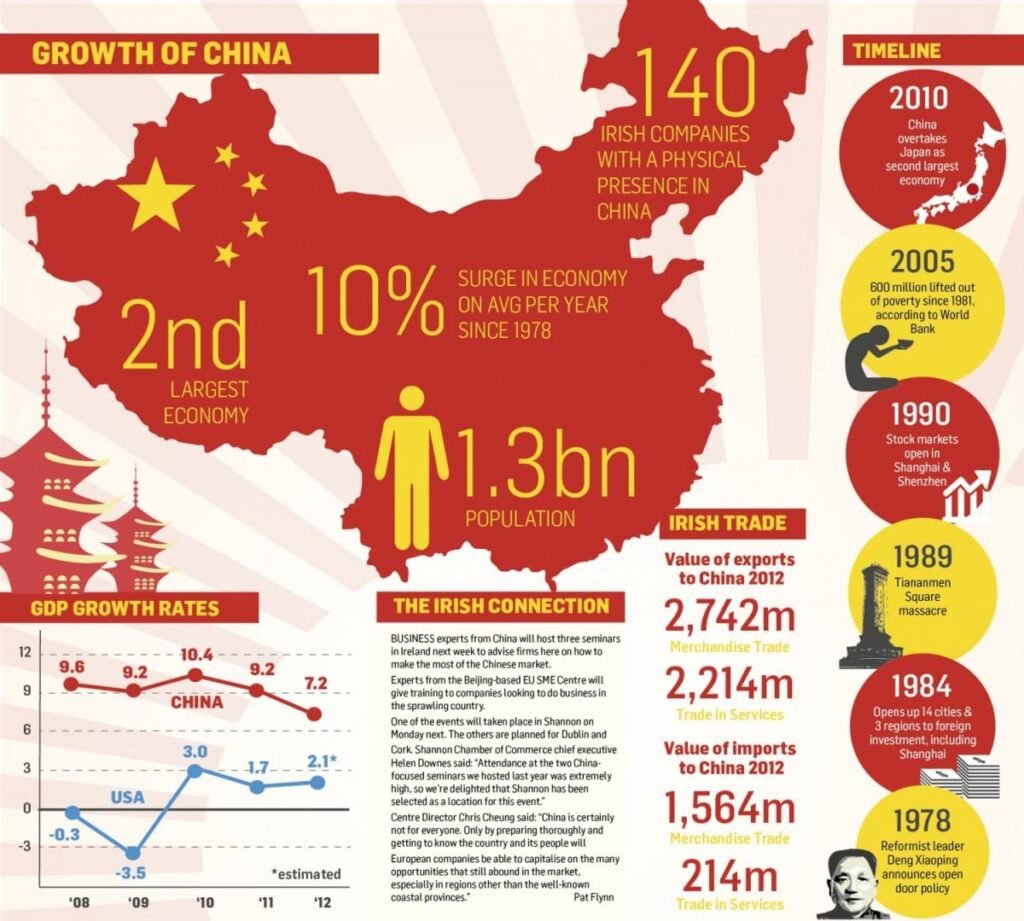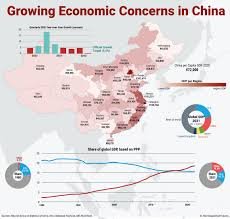China’s economic history spans thousands of years, marked by periods of innovation, prosperity, and stagnation. In the 20th century, China underwent significant political and economic transformations, including the establishment of the People’s Republic of China (PRC) in 1949 under Communist rule.
The period following the PRC’s founding was characterized by centrally planned economic policies, including the Great Leap Forward and the Cultural Revolution, which led to economic stagnation and social upheaval. In the late 1970s, under the leadership of Deng Xiaoping, China embarked on economic reforms, transitioning towards a socialist market economy.
Economic Structure
1. Primary Sector:
- Agriculture: Despite rapid industrialization, agriculture remains a crucial sector, employing a significant portion of the population.
- Natural Resources: China is rich in natural resources, including coal, iron ore, and rare earth minerals.
2. Secondary Sector:
- Manufacturing: China is the world’s largest manufacturer, known for its production of electronics, textiles, machinery, and more.
- Construction: Rapid urbanization has fueled robust construction activity, contributing to GDP growth.
3. Tertiary Sector:
- Services: The services sector has become increasingly important, encompassing finance, retail, technology, and entertainment.
- Tourism: China is a major tourist destination, attracting millions of domestic and international visitors annually.
Growth Drivers
1. Export-Led Growth:
- China leveraged its low-cost labor and vast manufacturing capabilities to become the “world’s factory,” exporting goods globally.
- Accession to the World Trade Organization (WTO) in 2001 facilitated greater integration into the global economy.

2. Investment and Infrastructure:
- Massive investment in infrastructure projects, including roads, railways, ports, and airports, spurred economic growth and connectivity.
- Infrastructure development supported industrialization, urbanization, and regional development initiatives.
3. Urbanization:
- Rapid urbanization has fueled domestic demand, driving consumption, real estate development, and services growth.
- The government’s urbanization policies aim to manage population movement efficiently while supporting sustainable development.
4. Technology and Innovation:
- China has prioritized technological advancement and innovation, investing heavily in research and development (R&D) and fostering a vibrant startup ecosystem.
- The rise of tech giants like Alibaba, Tencent, and Huawei has propelled China’s global competitiveness in digital technology.
Challenges
1. Debt and Financial Risks:
- China faces mounting debt levels, particularly among local governments and state-owned enterprises (SOEs), raising concerns about financial stability.
- Shadow banking activities and non-performing loans pose risks to the banking sector and broader economy.
2. Demographic Shifts:
- An aging population and declining birth rates present challenges such as a shrinking labor force, increased healthcare costs, and pension obligations.
- Addressing demographic challenges requires reforms to the pension system, healthcare, and family planning policies.

3. Environmental Degradation:
- Rapid industrialization and urbanization have led to environmental pollution, including air and water contamination, soil degradation, and deforestation.
- The government has implemented measures to mitigate environmental degradation, including stricter regulations, investments in renewable energy, and sustainable development initiatives.
4. Economic Inequality:
- Disparities in income and wealth between urban and rural areas, coastal and inland regions, and different socioeconomic groups pose social and economic challenges.
- Addressing income inequality requires policies to promote inclusive growth, improve social welfare, and enhance access to education and healthcare.
Future Prospects
1. Economic Rebalancing:
- China aims to transition towards a more sustainable and balanced growth model, emphasizing consumption, services, and innovation.
- Reforms to enhance domestic consumption, boost household income, and reduce reliance on exports are critical for long-term economic stability.
2. Technological Leadership:
- China seeks to become a global leader in technology and innovation, focusing on areas such as artificial intelligence, biotechnology, and renewable energy.
- Investments in R&D, talent development, and intellectual property protection are essential to foster a competitive innovation ecosystem.
3. Belt and Road Initiative (BRI):
- China’s BRI aims to enhance infrastructure connectivity and promote trade and investment across Asia, Africa, and Europe.
- The BRI presents opportunities for Chinese firms to expand overseas markets and influence regional economic dynamics, but it also faces geopolitical and financial risks.
4. Green Development:
- China is committed to pursuing green development strategies to address environmental challenges and promote sustainable growth.
- Investments in renewable energy, eco-friendly technologies, and green finance are central to China’s efforts to achieve carbon neutrality and ecological conservation goals.
China’s economy has undergone remarkable transformation and achieved rapid growth over the past few decades. However, it faces numerous challenges, including debt risks, demographic shifts, environmental degradation, and income inequality. Addressing these challenges while pursuing economic rebalancing, technological innovation, and sustainable development will be critical for China’s continued prosperity and global leadership in the 21st century.
